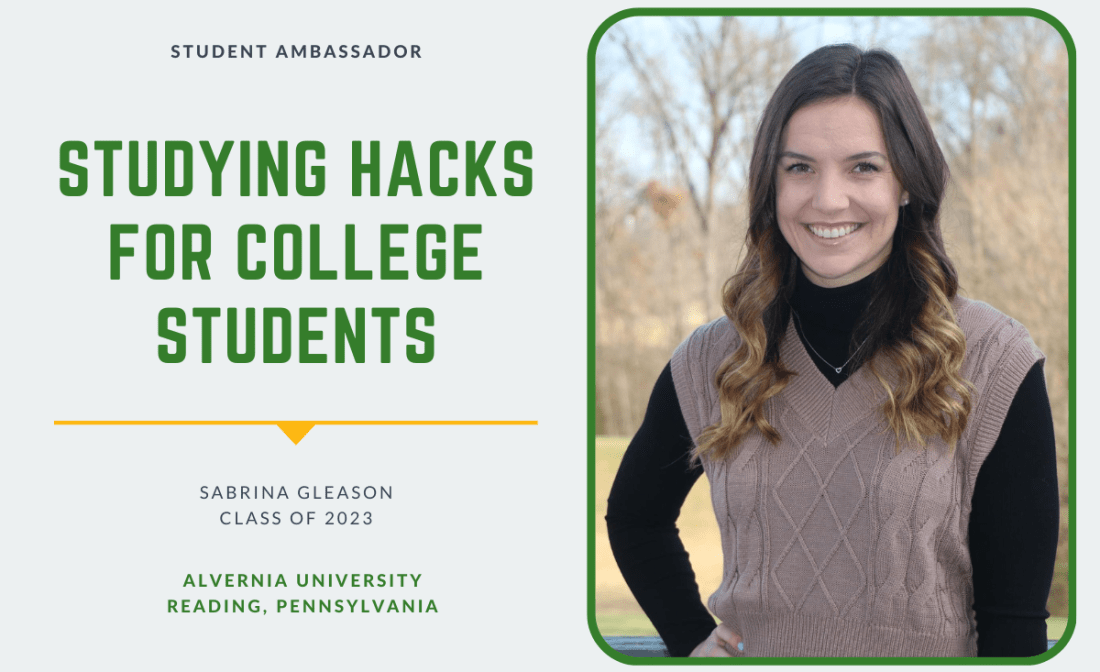Studying Hacks for College Students
You’ve graduated high school and are eager to begin your new college journey. You get all your required textbooks, notebooks, and a brand new laptop, ready to ace your courses. You’re following along diligently in class, and asking questions as you go. Then your first test comes, and you have no idea how to take all the information you were just given and somehow organize it in a way that your brain can process it all.
It happens to the best of us. We do really well in high school, achieving high honors and a great GPA that got us into the university of our dreams. But once we reach college, we find that the class organization is a lot different, and we quickly realize that we’re struggling to adjust. Instead of being in class every day from 8am-3pm like in high school, maybe your class meets for an hour every other day. It’s much less time in the classroom and more time on your own. It is certainly an adjustment that every college student faces. As a senior nursing student at Alvernia University, I have mastered a couple study strategies that will help you be successful when it comes to taking tests.
1) Discover Your Learning Style
I would recommend starting out by reflecting on what your learning style is. Some people are visual learners, while others may be more hands on. Whether you like to hear new information or see it written in textbooks, it’s essential to be self aware and know where your strengths are.
For me, I am a visual learner, and I am able to process information the best through color coding diagrams. Other people may like to watch YouTube videos and hear other people explaining the concept to them. If you’re a kinesthetic learner, you can attend open lab times. This first step is so crucial, and it may take some time to find what’s best for you. Be patient with yourself as you navigate this.
2) Repetition, Repetition, Repetition.
If I write it once, I write it three times. I know it may sound tedious, and it is, but it works. Being a visual learner, I like to see my notes organized on paper. I’ll print out the PowerPoint prior to class and take notes on it while in lecture. Then I’ll come home and rewrite them in a notebook, because I hate the messiness of my scribbles from class. I’ll add notes that I read from the textbook in a separate color so I can differentiate what the professor stressed versus what information I’m supplementing.
I’ll then take a blank sheet of printer paper and write a major concept at the top followed by all the information I need to know under it on the page. That way, I have one page I can refer to for every important concept that will be on the test. This is more for the “big ideas” that I can see organized in a creative way. I can go back to my detailed notes if I need to look for more information. You don’t want too many words on your paper, or it won’t be as effective. It’s more of like a cheat sheet to help you remember key points.
3) Make It Stick
Mnemonics and pictures are your friend. As silly as it may sound, this is what you’ll remember when you’re sitting there at your test. If you can visualize the picture in your head as you’re taking your exam, that will help you access the information and answer the question. You can write down the mnemonic when you get your exam and refer back to it when the question comes up. Coming up with a picture is also helping you synthesize the information you learned and make something from it. That alone is so helpful.
4) Choose Your Best Study Environment
The setting you study in is important. Your university’s library will often have many floors. Some are quiet floors, while others are for group work. Here where to continue your self-reflection: figure out whether you can or can’t study with friends alongside you. It’s very common to study with friends in college. However, I caution you in doing so if you get easily distracted. Sometimes studying with your friends for two hours can turn into fun and throw you off topic. You might have been able to get the same amount of work done by yourself in 40 minutes.
Optimizing time is crucial so you can ensure you are able to review all the material necessary. Personally, I study best in my living room. I lay out all my colorful pens, papers, concept maps, and textbooks, and then I dive in for hours at a time. I know that I get too distracted in the library with people around me. You will have to find what works best for you.
5) The Pomodoro Technique
Lastly, the “Pomodoro Technique” is a great method for helping you stay focused on studying. This method is where you set a timer for 25 minutes to grind out some work and then reward yourself with a 5-10 minute break. Then restart the 25 minute timer. During the 5-10 minute break, try stepping away from your study spot by taking a walk or grabbing a snack. Don’t sit in the same spot and go on your phone. Get up to do something so you don’t fall asleep or get antsy as you sit there for hours at a time.
Studying for an exam begins on day one, and it’s so beneficial to keep up with the material and assess your understanding as you go. Cramming the night before will never work. It takes hard work and some adjusting along the way. Believe in yourself, get help from your college’s tutoring center, meet with your professor and, most importantly, don’t ever give up.




